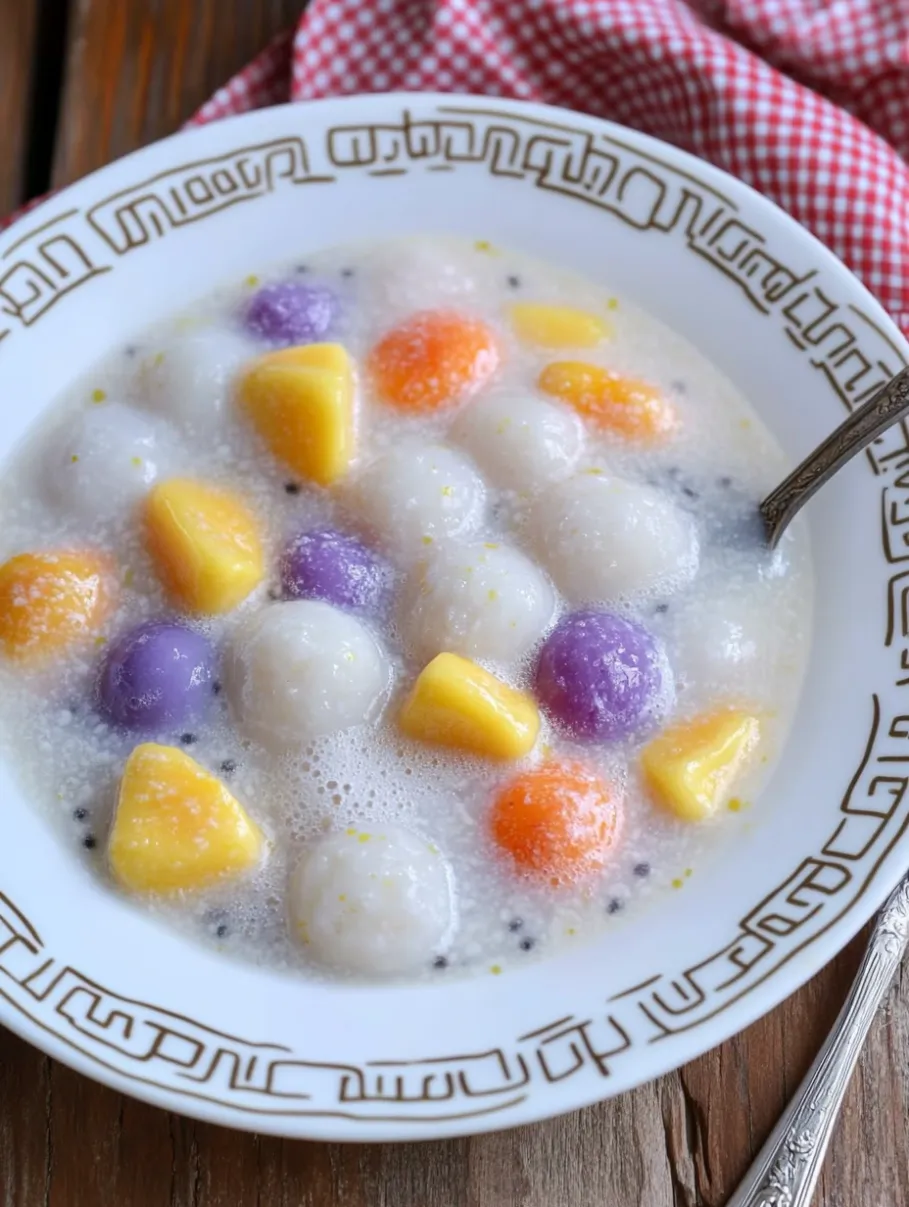 Save
Save
This ginataang bilo bilo recipe transports me to childhood afternoons in my grandmother's kitchen where the sweet aroma of coconut milk filled the air. The combination of chewy rice balls, sweet fruits, and creamy coconut creates a comforting dessert that perfectly balances textures and flavors in every spoonful.
I first made this traditional Filipino treat during a family reunion, and watching my cousins' faces light up with nostalgia made all the effort worthwhile. Now it's become our go-to comfort dessert for gatherings large and small.
Ingredients
- Glutinous rice flour: creates those signature chewy balls that give bilo bilo its distinctive texture
- Water: helps bind the dough and creates the right consistency for the broth
- Coconut milk: provides the rich, creamy base that defines this dessert
- Cooked tapioca pearls: add extra chewiness and visual appeal to each serving
- Sugar: balances the richness with just the right level of sweetness
- Sweet potatoes: contribute natural sweetness and a soft, tender bite
- Plantain bananas: offer tropical flavor and hold their shape when cooked
- Jackfruit: brings unique sweetness and distinctive texture to the dessert
Step-by-Step Instructions
- Prepare Sticky Rice Balls:
- Mix 2 cups glutinous rice flour with 1 cup water using a fork until it forms a pliable dough. Scoop small portions and roll between your palms to form marble-sized balls. The texture should be soft but not sticky. Place them on a plate without touching each other to prevent sticking.
- Create Coconut Base:
- Combine 2 cups water, coconut milk, and sugar in a large pot and bring to a gentle boil over medium heat. Stir occasionally to ensure the sugar dissolves completely and prevent the coconut milk from curdling. The liquid should be fragrant with a slightly sweet aroma.
- Cook Root Vegetables:
- Add sweet potato cubes first, as they take longer to soften. Simmer for 3 minutes while stirring gently. The sweet potatoes should begin to soften but still maintain their shape. Then add plantain banana cubes and cook for another 3 minutes until they start to become tender.
- Add Rice Balls:
- Gently drop the prepared sticky rice balls into the simmering liquid one by one to prevent splashing and sticking. Cook for approximately 5 minutes, stirring occasionally with a wooden spoon. The rice balls will float to the surface when they are cooked through.
- Finish With Fruits:
- Add jackfruit slices and cooked tapioca pearls to the pot. These ingredients need minimal cooking time. Simmer everything together for a final 3-5 minutes until all components are tender and the mixture has thickened slightly.
- Serve With Care:
- Remove from heat and let it rest for a few minutes. The mixture will continue to thicken as it cools. Serve in bowls either piping hot or chilled depending on your preference.
 Save
Save
The jackfruit is my absolute favorite ingredient in this recipe. When I was growing up, my mother would always save extra pieces of jackfruit for me to nibble on while she prepared the rest of the dessert. That sweet, tropical flavor remains etched in my memory and transports me back to those special moments every time I make this dish.
Storage Magic
Ginataang bilo bilo will keep in the refrigerator for up to 3 days in an airtight container. The flavors actually deepen overnight, making it even more delicious the next day. The mixture will thicken considerably when chilled, so when reheating, add a splash of water or coconut milk to reach your desired consistency. Gently warm over low heat, stirring frequently to prevent scorching the coconut milk.
Creative Variations
This recipe welcomes adaptation based on what tropical fruits you can find. Purple yam (ube) makes a colorful and flavorful alternative to sweet potatoes. Ripe mangoes add bright citrusy notes when added in the final minutes of cooking. For texture contrast, try adding young coconut flesh or even sago pearls instead of tapioca. Some regions in the Philippines include corn kernels for added sweetness and texture.
Cultural Significance
Ginataang bilo bilo belongs to a family of Filipino desserts called ginataan, which simply means "cooked with coconut milk." This particular version is often prepared during special occasions and family gatherings. In rural areas, it represents community as neighbors might contribute different ingredients from their gardens. The dessert embodies Filipino food philosophy of combining various textures and balancing sweet flavors with rich coconut.
Serving Suggestions
For a truly authentic experience, serve ginataang bilo bilo in small bowls as an afternoon merienda (snack) alongside hot tea or coffee. During summer months, refrigerate it for a few hours and serve cold as a refreshing dessert. For a modern twist, portion into small glasses and top with toasted coconut flakes for a sophisticated dessert party presentation.
Frequently Asked Questions About Recipes
- → What is Ginataang Bilo Bilo made of?
It is made from glutinous rice balls, plantain bananas, sweet potatoes, jackfruit strips, tapioca pearls, sugar, and coconut milk.
- → Can I serve Ginataang Bilo Bilo cold?
Yes, it can be served hot or cold, depending on your preference.
- → How do I know the rice balls are cooked?
The rice balls are cooked when they float to the surface of the boiling liquid.
- → Can I add food coloring to the rice balls?
Yes, you can add food coloring to the dough before forming the rice balls to enhance their appearance.
- → What can I use as a substitute for jackfruit?
You can substitute jackfruit with mango or other tropical fruits for a similar flavor.
